Project Overview
Autism spectrum disorder (ASD) impacts social communication and interaction as it is a developmental disorder. While symptoms may differ from person to person, many individuals with autism experience challenges with sensory processing, inflexible thinking, anxiety, and repeating behaviors. A number of areas of life, including work, education, independence, and using public transit, present difficulties for the autism community.
ROLE
User Research
Wireframing
Prototyping
PERIOD
February - April 2024
TOOLS
Figma
Google Creative Suite
MAXQDA
TEAM
Howard Le
Jennifer Purington
Mark D’Antonio
Ky’mani Brown
Winter Graham
RESEARCH
Background
Our team met with two experts within the autistic community:
- Nigel Newbutt, Director of the Equitable Learning Technology Lab
- Ann Marie Orlando, Director of Center for Autism and Related Disabilities
Through our discussions, it was clear to us how difficult public transportation can be for the autistic community due to sensory issues, sudden changes, and overall confusion. The ability to transport oneself independently is crucial for fostering a sense of autonomy and empowerment, particularly for individuals in the autistic community, as it provides a means to navigate the world on their terms, promoting confidence and self-reliance.
Data Analysis
To understand this issue better, our group utilized Online Ethnography:
5
Videos Reviewed
100
Community Posts
We reviewed videos from individuals and communities a part of the Autistic community that discussed their struggles with public transportation. Additionally, we conducted a thematic analysis of written posts from various online communities consisting of individuals a part of related communities.
MAXQDA Word Cloud
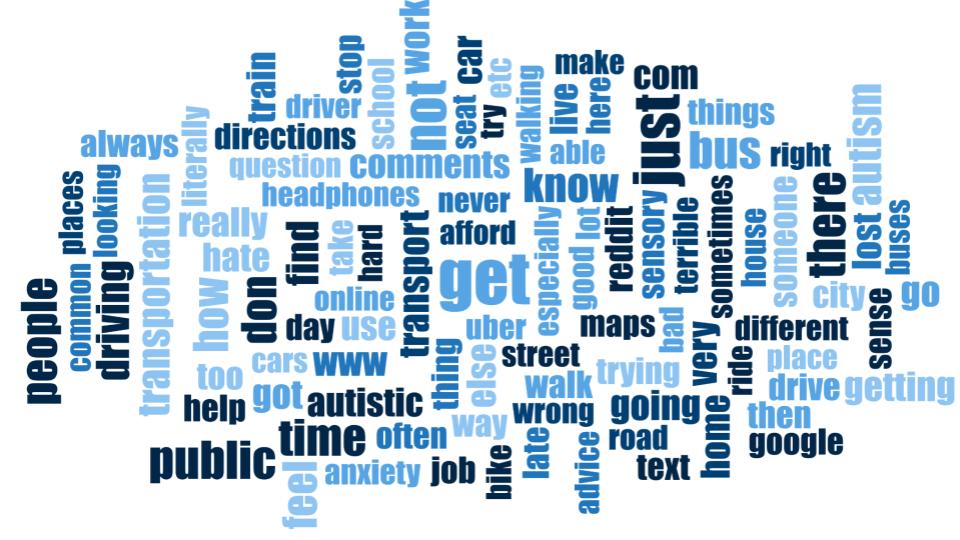
Thematic Analysis Key Findings
💥 Sensory Overload
- Loud Noises
- Weird Smells
- Large Crowds
“It is overwhelming. I don’t know how to deal with this, it makes long trips unbearable.”
✅ Helpful Techniques
- Headphones
- Breathing
- Phone Games
“I always carry things to keep my mind busy. Books, music, puzzle apps on my phone, I find if I distract myself it helps keep my anxiety in check.”
🤷 Unpredictability
- Traffic
- People Moving
- Changing ETAs
“It’s just too unpredictable and there is too much change happening constantly.”
Competitor Analysis Analysis
Google Maps
Strengths
- Offline routes available
- Live accessibility statuses
- Step-by-step route assistance
Weaknesses
- Lack of dedicated assistance for Autistic individuals
- No live-bus location display
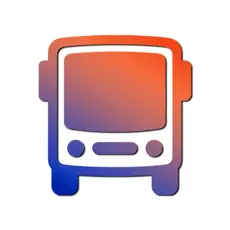
Navigator
Strengths
- Real-time bus location display
- Includes trip planning assistance
- Estimate Bus Arrival Time
Weaknesses
- No Realtime support
- No emotional regulation assistance
- No support for unpredictable events

Citymapper
Strengths
- Utilizes user-generated data
- “Fast Route” and “Main Road” options
- Includes live timing
Weaknesses
- Limited app availability
- Overwhelming user interface
- Limited accessibility features & support
DEFINE
Affinity Diagram
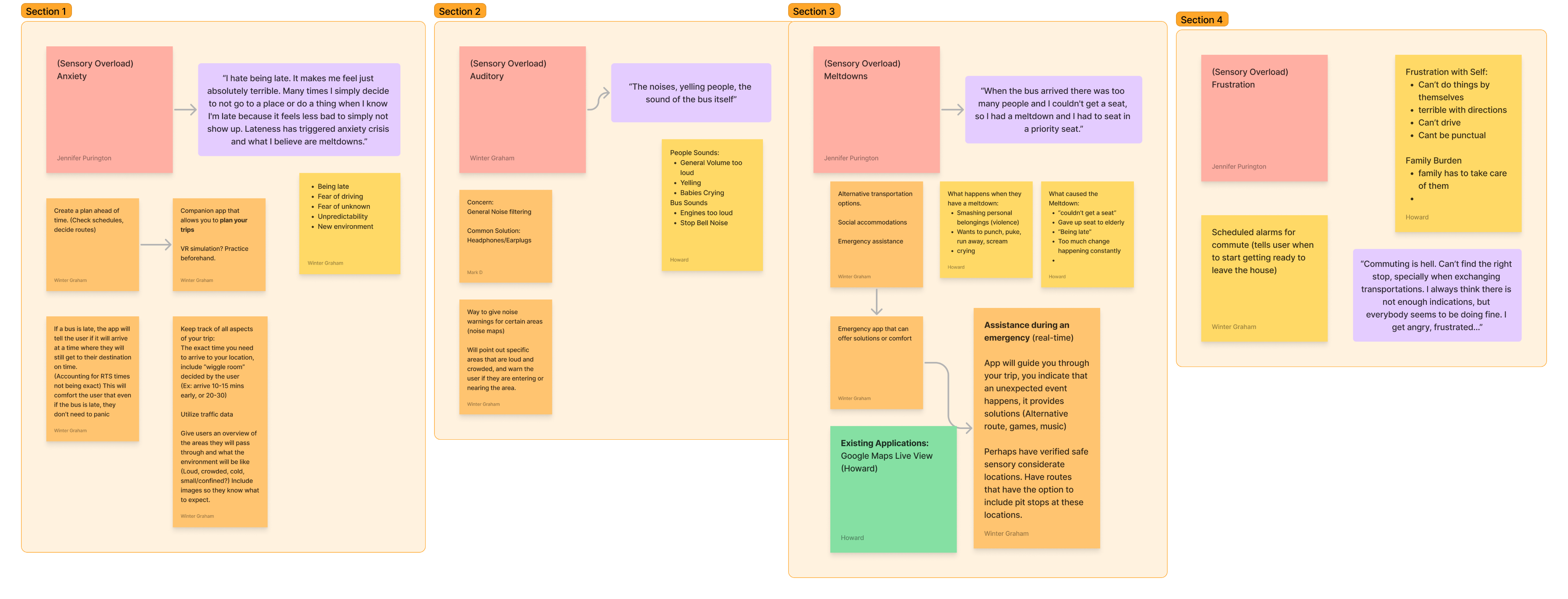
User Persona

Alex
Age: 20 years old
Occupation: Full Time Student at UF
Location: Gainesville, FL
Goals:
- Successfully navigate to and from school on a daily basis without the assistance of friends/family
- Finish getting their bachelors degree and prepare for getting a job
Frustrations:
- Certain situations require different tools to communicate her thoughts.
- Has meltdown when overstimulated.
Card Sorting
My team and I each spent a few minutes creating labels that we thought would work well for our app. After completing this task, we gave our cards to a different group of participants and allowed them to sort the labels into categories that they thought were most logical. Pictured below are the results of the activity.
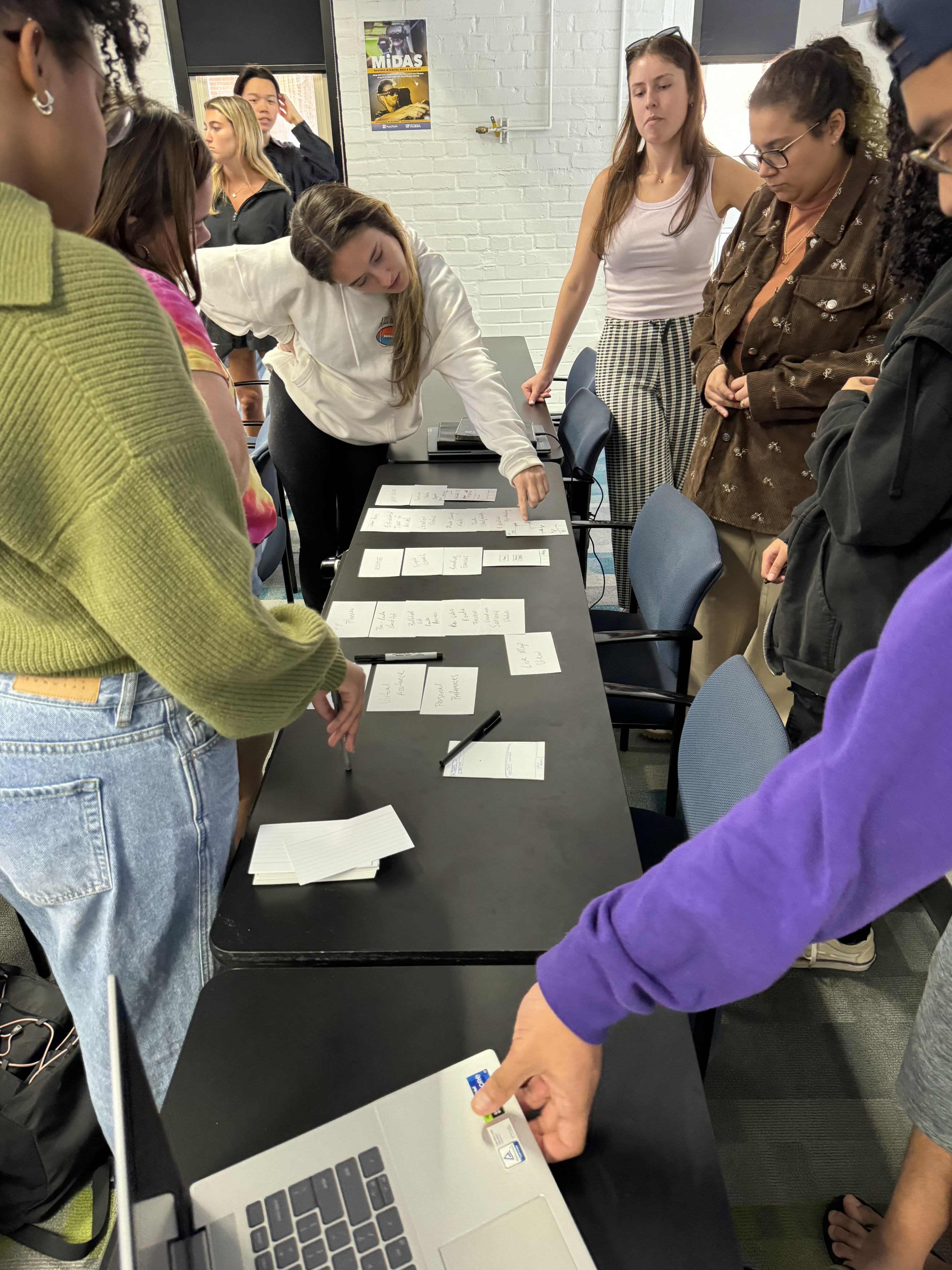
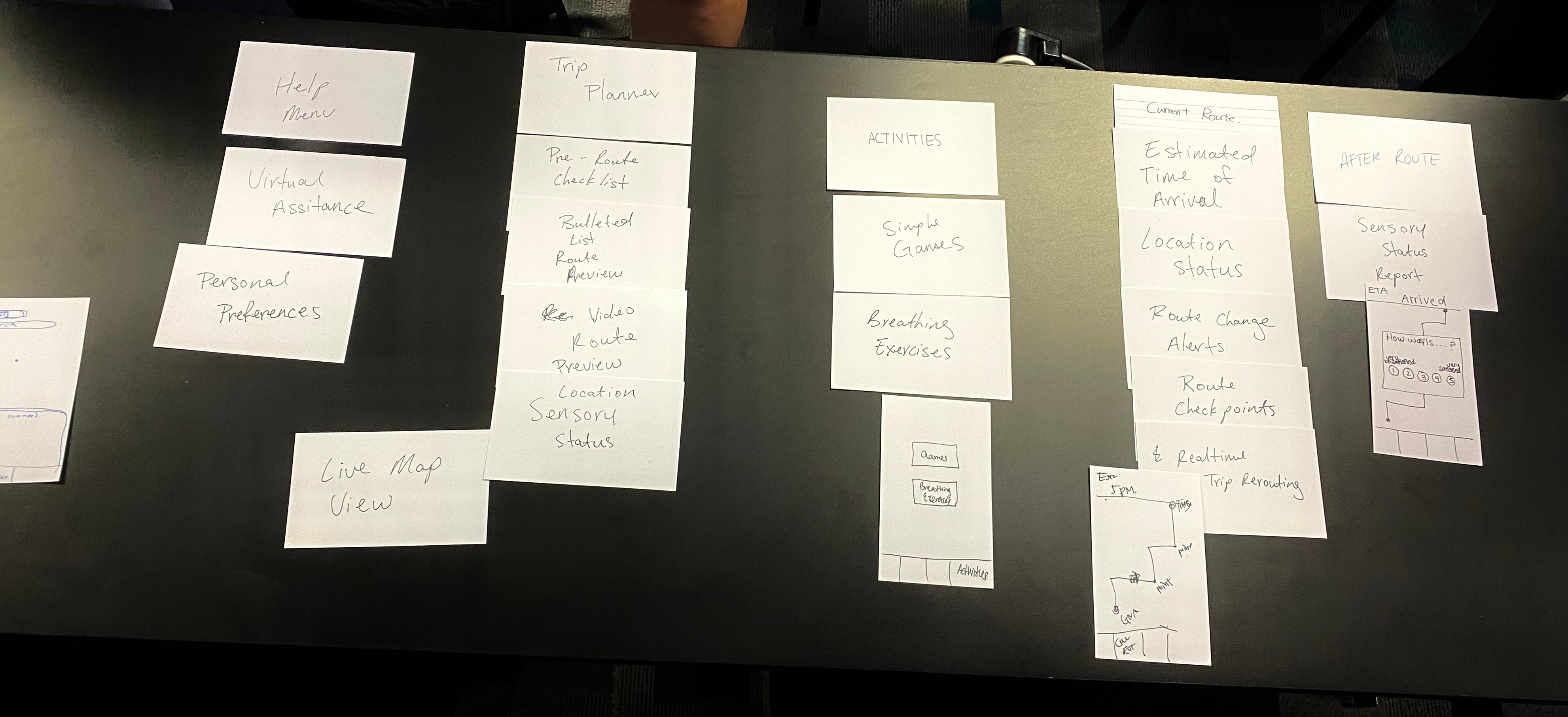
IDEATE
Product Goals
01. Preemptive Trip Planning
02. Address Unpredictable Events
03. Prevent Spontaneous Meltdowns
04. Real-time Assistance During Emergencies
Design Requirements
- Be able to investigate different travel routes (visualize trip locations)
- Checkpoints, markers where landmarks are on the route to ensure the user is on path.
- Preparatory suggestions for trips
- Reroute trip in case of emergency
- Provide solutions for unexpected hurdles
- Live updates for unexpected changes in travel route
- Notifications/Markers for when user is approaching high stress area
- Direct user to secluded environment
- Having a companion to talk to to have some sort of distraction
- Be able to get customized advice during a stressful situation
- Offer exercises to reduce stress, breathing exercises, mindfulness, etc.
Application Map

DESIGN
Branding & Style Guidelines
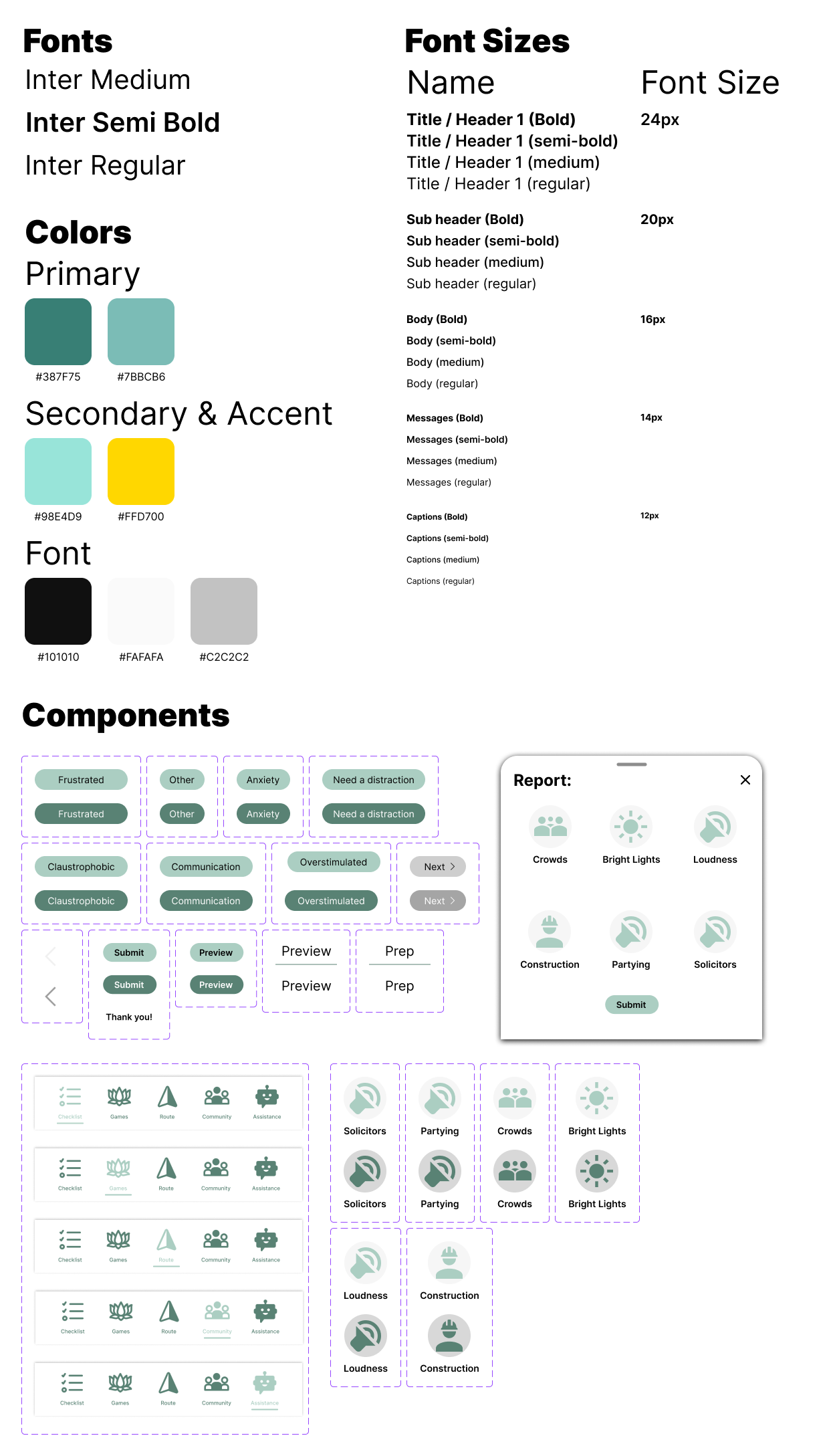
Low Fidelity Wireframes
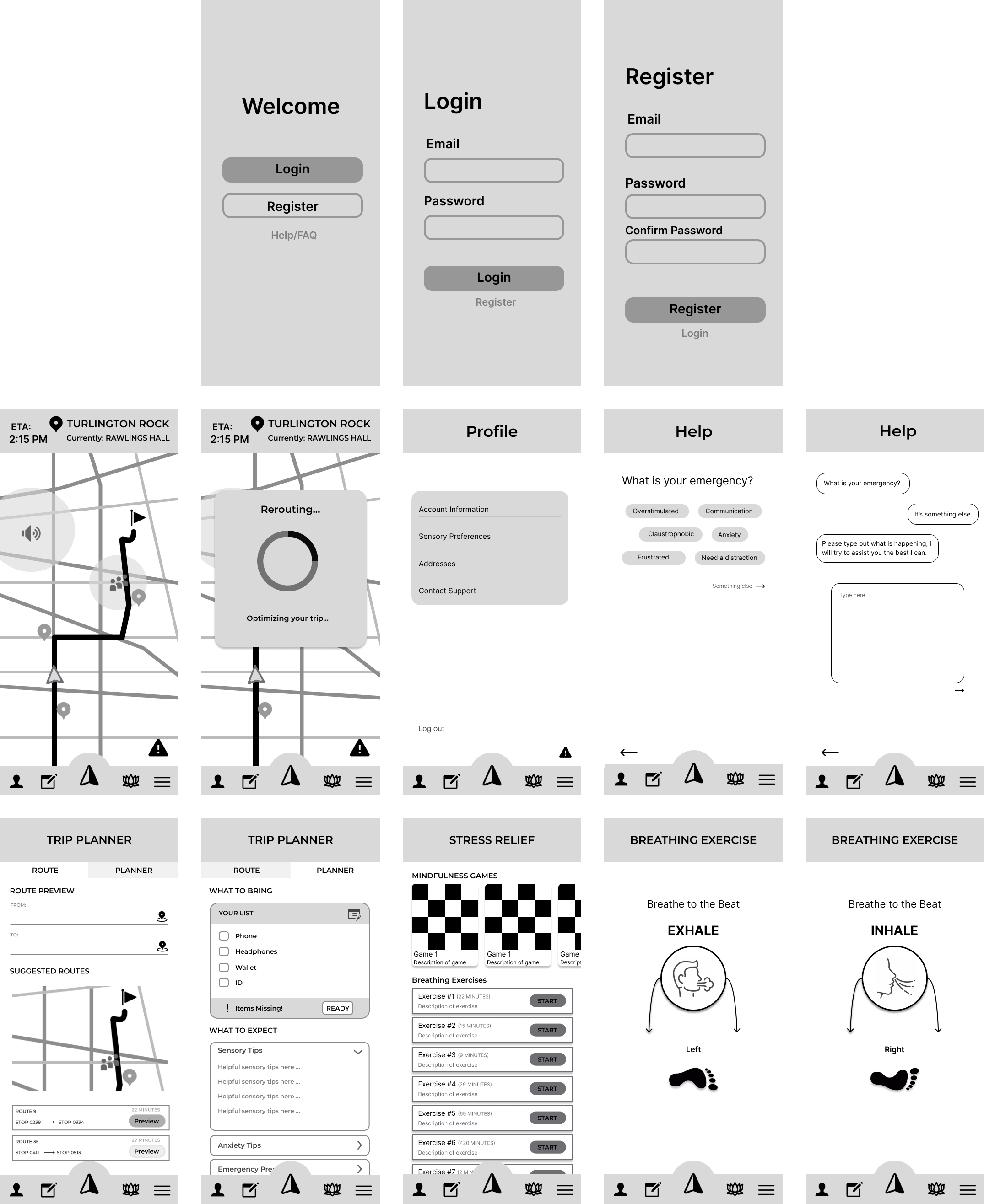
- Be able to investigate different travel routes (visualize trip locations)
- Checkpoints, markers where landmarks are on the route to ensure the user is on path.
- Preparatory suggestions for trips
- Reroute trip in case of emergency
- Provide solutions for unexpected hurdles
- Live updates for unexpected changes in travel route
- Notifications/Markers for when user is approaching high stress area
- Direct user to secluded environment
- Having a companion to talk to to have some sort of distraction
- Be able to get customized advice during a stressful situation
- Offer exercises to reduce stress, breathing exercises, mindfulness, etc.
Focus Group Interview - Preliminary Findings
Our team conducted initial user testing with the first version of our prototype to gather more in-depth feedback from potential users. Some feedback we received is as follows:
- Enhance app navigation text for improved readability.
- Include “Community” section in navigation bar to increase feeling of in-person support.
- Keep interface focused on navigation path to prevent distractions.
- Implement ability for live rerouting and access to quiet places.
High-Fidelity Prototype

Pre-Trip Planner & Route Preview
The user can create customizable lists to help themselves remember any items needed for the trip.
The user can access a detailed preview of their trip consisting of assistive images and videos.
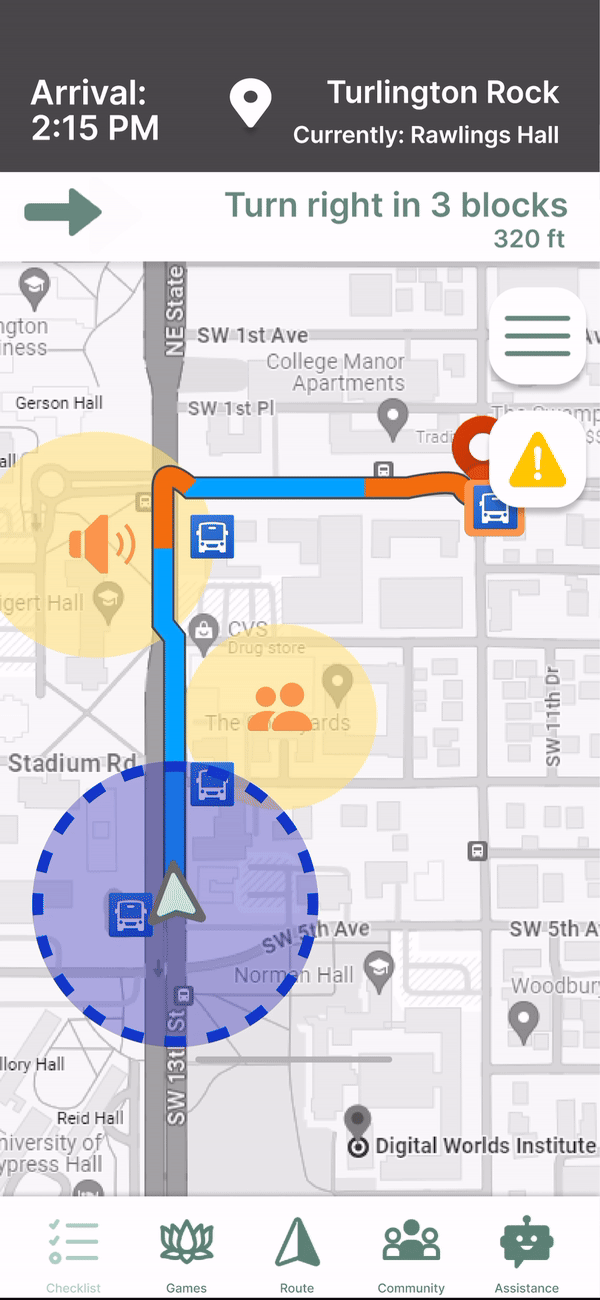
In-App Reporting & Alerts
Upon encountering non-sensory safe situations, users can report it live, alerting nearby app users of the situation.

In-App Reporting & Alerts
The user can access a variety of Mindfulness Games or perform Breathing Exercises to make their trip more relaxing.

Real-time Chatting
App users are able to chat with nearby travelers to improve sense of community and have access to assistance if needed.
TEST
User Testing
Finally, we conducted usability tests with our high-fidelity prototypes. For our user testing, we utilized Maze.com. We mainly tested users on how well they could navigate given tasks such as:
- Locating the “Reporting Hazard” button to report a loud noise
- Accessing a Route Preview from within the Trip Planner
- Completing a Breathing Exercise starting from the home screen.
Final Thoughts
I have found this project to be extremely rewarding as I had the opportunity to work with a talented team to tackle an issue that is often overlooked. Through this process, I have learned how to analyze insights from online sources using industry programs as well as how to better design for those with greater accessibility needs.
I believe TranquilTravels is an exciting spot however I believe there are ways that it can still be improved. I would love to take things further by expanding this application on to other external applications such as wearables.
Ultimate Statsheet
VR Data Visualization
WORK
PLAY
ABOUT
RESUMÉ
Project Overview
Autism spectrum disorder (ASD) impacts social communication and interaction as it is a developmental disorder. While symptoms may differ from person to person, many individuals with autism experience challenges with sensory processing, inflexible thinking, anxiety, and repeating behaviors. A number of areas of life, including work, education, independence, and using public transit, present difficulties for the autism community.
ROLE
User Research
Wireframing
Prototyping
PERIOD
February - April 2024
TOOLS
Figma
Google Creative Suite
MAXQDA
TEAM
Howard Le
Jennifer Purington
Mark D’Antonio
Ky’mani Brown
Winter Graham
RESEARCH
Background
Our team met with two experts within the autistic community:
- Nigel Newbutt, Director of the Equitable Learning Technology Lab
- Ann Marie Orlando, Director of Center for Autism and Related Disabilities
Through our discussions, it was clear to us how difficult public transportation can be for the autistic community due to sensory issues, sudden changes, and overall confusion. The ability to transport oneself independently is crucial for fostering a sense of autonomy and empowerment, particularly for individuals in the autistic community, as it provides a means to navigate the world on their terms, promoting confidence and self-reliance.
Data Analysis
To understand this issue better, our group utilized Online Ethnography:
5
Videos Reviewed
100
Community Posts
We reviewed videos from individuals and communities a part of the Autistic community that discussed their struggles with public transportation. Additionally, we conducted a thematic analysis of written posts from various online communities consisting of individuals a part of related communities.
MAXQDA Word Cloud

Thematic Analysis Key Findings
💥 Sensory Overload
- Loud Noises
- Weird Smells
- Large Crowds
“It is overwhelming. I don’t know how to deal with this, it makes long trips unbearable.”
✅ Helpful Techniques
- Headphones
- Breathing
- Phone Games
“I always carry things to keep my mind busy. Books, music, puzzle apps on my phone, I find if I distract myself it helps keep my anxiety in check.”
🤷 Unpredictability
- Traffic
- People Moving
- Changing ETAs
“It’s just too unpredictable and there is too much change happening constantly.”
Competitor Analysis Analysis
Google Maps
Strengths
- Offline routes available
- Live accessibility statuses
- Step-by-step route assistance
Weaknesses
- Lack of dedicated assistance for Autistic individuals
- No live-bus location display

Navigator
Strengths
- Real-time bus location display
- Includes trip planning assistance
- Estimate Bus Arrival Time
Weaknesses
- No Realtime support
- No emotional regulation assistance
- No support for unpredictable events

Citymapper
Strengths
- Utilizes user-generated data
- “Fast Route” and “Main Road” options
- Includes live timing
Weaknesses
- Limited app availability
- Overwhelming user interface
- Limited accessibility features & support
DEFINE
Affinity Diagram

User Persona

Alex
Age: 20 years old
Occupation: Full Time Student at UF
Location: Gainesville, FL
Goals:
- Successfully navigate to and from school on a daily basis without the assistance of friends/family
- Finish getting their bachelors degree and prepare for getting a job
Frustrations:
- Certain situations require different tools to communicate her thoughts.
- Has meltdown when overstimulated.
Card Sorting
My team and I each spent a few minutes creating labels that we thought would work well for our app. After completing this task, we gave our cards to a different group of participants and allowed them to sort the labels into categories that they thought were most logical. Pictured below are the results of the activity.


IDEATE
Product Goals
01. Preemptive Trip Planning
02. Address Unpredictable Events
03. Prevent Spontaneous Meltdowns
04. Real-time Assistance During Emergencies
Design Requirements
- Be able to investigate different travel routes (visualize trip locations)
- Checkpoints, markers where landmarks are on the route to ensure the user is on path.
- Preparatory suggestions for trips
- Reroute trip in case of emergency
- Provide solutions for unexpected hurdles
- Live updates for unexpected changes in travel route
- Notifications/Markers for when user is approaching high stress area
- Direct user to secluded environment
- Having a companion to talk to to have some sort of distraction
- Be able to get customized advice during a stressful situation
- Offer exercises to reduce stress, breathing exercises, mindfulness, etc.
Application Map

DESIGN
Branding & Style Guidelines

Low Fidelity Wireframes

- Be able to investigate different travel routes (visualize trip locations)
- Checkpoints, markers where landmarks are on the route to ensure the user is on path.
- Preparatory suggestions for trips
- Reroute trip in case of emergency
- Provide solutions for unexpected hurdles
- Live updates for unexpected changes in travel route
- Notifications/Markers for when user is approaching high stress area
- Direct user to secluded environment
- Having a companion to talk to to have some sort of distraction
- Be able to get customized advice during a stressful situation
- Offer exercises to reduce stress, breathing exercises, mindfulness, etc.
Focus Group Interview - Preliminary Findings
Our team conducted initial user testing with the first version of our prototype to gather more in-depth feedback from potential users. Some feedback we received is as follows:
- Enhance app navigation text for improved readability.
- Include “Community” section in navigation bar to increase feeling of in-person support.
- Keep interface focused on navigation path to prevent distractions.
- Implement ability for live rerouting and access to quiet places.
High-Fidelity Prototype

Pre-Trip Planner & Route Preview
The user can create customizable lists to help themselves remember any items needed for the trip.
The user can access a detailed preview of their trip consisting of assistive images and videos.

In-App Reporting & Alerts
Upon encountering non-sensory safe situations, users can report it live, alerting nearby app users of the situation.

In-App Reporting & Alerts
The user can access a variety of Mindfulness Games or perform Breathing Exercises to make their trip more relaxing.

Real-time Chatting
App users are able to chat with nearby travelers to improve sense of community and have access to assistance if needed.
TEST
User Testing
Finally, we conducted usability tests with our high-fidelity prototypes. For our user testing, we utilized Maze.com. We mainly tested users on how well they could navigate given tasks such as:
- Locating the “Reporting Hazard” button to report a loud noise
- Accessing a Route Preview from within the Trip Planner
- Completing a Breathing Exercise starting from the home screen.
Final Thoughts
I have found this project to be extremely rewarding as I had the opportunity to work with a talented team to tackle an issue that is often overlooked. Through this process, I have learned how to analyze insights from online sources using industry programs as well as how to better design for those with greater accessibility needs.
I believe TranquilTravels is an exciting spot however I believe there are ways that it can still be improved. I would love to take things further by expanding this application on to other external applications such as wearables.
Ultimate Statsheet
VR Data Visualization
WORK
PLAY
ABOUT
RESUMÉ
Project Overview
Autism spectrum disorder (ASD) impacts social communication and interaction as it is a developmental disorder. While symptoms may differ from person to person, many individuals with autism experience challenges with sensory processing, inflexible thinking, anxiety, and repeating behaviors. A number of areas of life, including work, education, independence, and using public transit, present difficulties for the autism community.
ROLE
User Research
Wireframing
Prototyping
PERIOD
February - April 2024
TOOLS
Figma
Google Creative Suite
MAXQDA
TEAM
Howard Le
Jennifer Purington
Mark D’Antonio
Ky’mani Brown
Winter Graham
RESEARCH
Background
Our team met with two experts within the autistic community:
- Nigel Newbutt, Director of the Equitable Learning Technology Lab
- Ann Marie Orlando, Director of Center for Autism and Related Disabilities
Through our discussions, it was clear to us how difficult public transportation can be for the autistic community due to sensory issues, sudden changes, and overall confusion. The ability to transport oneself independently is crucial for fostering a sense of autonomy and empowerment, particularly for individuals in the autistic community, as it provides a means to navigate the world on their terms, promoting confidence and self-reliance.
Data Analysis
To understand this issue better, our group utilized Online Ethnography:
5
Videos Reviewed
100
Community Posts
We reviewed videos from individuals and communities a part of the Autistic community that discussed their struggles with public transportation. Additionally, we conducted a thematic analysis of written posts from various online communities consisting of individuals a part of related communities.
MAXQDA Word Cloud

Thematic Analysis Key Findings
💥 Sensory Overload
- Loud Noises
- Weird Smells
- Large Crowds
“It is overwhelming. I don’t know how to deal with this, it makes long trips unbearable.”
✅ Helpful Techniques
- Headphones
- Breathing
- Phone Games
“I always carry things to keep my mind busy. Books, music, puzzle apps on my phone, I find if I distract myself it helps keep my anxiety in check.”
🤷 Unpredictability
- Traffic
- People Moving
- Changing ETAs
“It’s just too unpredictable and there is too much change happening constantly.”
Competitor Analysis Analysis
Google Maps
Strengths
- Offline routes available
- Live accessibility statuses
- Step-by-step route assistance
Weaknesses
- Lack of dedicated assistance for Autistic individuals
- No live-bus location display

Navigator
Strengths
- Real-time bus location display
- Includes trip planning assistance
- Estimate Bus Arrival Time
Weaknesses
- No Realtime support
- No emotional regulation assistance
- No support for unpredictable events

Citymapper
Strengths
- Utilizes user-generated data
- “Fast Route” and “Main Road” options
- Includes live timing
Weaknesses
- Limited app availability
- Overwhelming user interface
- Limited accessibility features & support
DEFINE
Affinity Diagram

User Persona

Alex
Age: 20 years old
Occupation: Full Time Student at UF
Location: Gainesville, FL
Goals:
- Successfully navigate to and from school on a daily basis without the assistance of friends/family
- Finish getting their bachelors degree and prepare for getting a job
Frustrations:
- Certain situations require different tools to communicate her thoughts.
- Has meltdown when overstimulated.
Card Sorting
My team and I each spent a few minutes creating labels that we thought would work well for our app. After completing this task, we gave our cards to a different group of participants and allowed them to sort the labels into categories that they thought were most logical. Pictured below are the results of the activity.


IDEATE
Product Goals
01. Preemptive Trip Planning
02. Address Unpredictable Events
03. Prevent Spontaneous Meltdowns
04. Real-time Assistance During Emergencies
Design Requirements
- Be able to investigate different travel routes (visualize trip locations)
- Checkpoints, markers where landmarks are on the route to ensure the user is on path.
- Preparatory suggestions for trips
- Reroute trip in case of emergency
- Provide solutions for unexpected hurdles
- Live updates for unexpected changes in travel route
- Notifications/Markers for when user is approaching high stress area
- Direct user to secluded environment
- Having a companion to talk to to have some sort of distraction
- Be able to get customized advice during a stressful situation
- Offer exercises to reduce stress, breathing exercises, mindfulness, etc.
Application Map

DESIGN
Branding & Style Guidelines

Low Fidelity Wireframes

- Be able to investigate different travel routes (visualize trip locations)
- Checkpoints, markers where landmarks are on the route to ensure the user is on path.
- Preparatory suggestions for trips
- Reroute trip in case of emergency
- Provide solutions for unexpected hurdles
- Live updates for unexpected changes in travel route
- Notifications/Markers for when user is approaching high stress area
- Direct user to secluded environment
- Having a companion to talk to to have some sort of distraction
- Be able to get customized advice during a stressful situation
- Offer exercises to reduce stress, breathing exercises, mindfulness, etc.
Focus Group Interview - Preliminary Findings
Our team conducted initial user testing with the first version of our prototype to gather more in-depth feedback from potential users. Some feedback we received is as follows:
- Enhance app navigation text for improved readability.
- Include “Community” section in navigation bar to increase feeling of in-person support.
- Keep interface focused on navigation path to prevent distractions.
- Implement ability for live rerouting and access to quiet places.
High-Fidelity Prototype

Pre-Trip Planner & Route Preview
The user can create customizable lists to help themselves remember any items needed for the trip.
The user can access a detailed preview of their trip consisting of assistive images and videos.

In-App Reporting & Alerts
Upon encountering non-sensory safe situations, users can report it live, alerting nearby app users of the situation.

In-App Reporting & Alerts
The user can access a variety of Mindfulness Games or perform Breathing Exercises to make their trip more relaxing.

Real-time Chatting
App users are able to chat with nearby travelers to improve sense of community and have access to assistance if needed.
TEST
User Testing
Finally, we conducted usability tests with our high-fidelity prototypes. For our user testing, we utilized Maze.com. We mainly tested users on how well they could navigate given tasks such as:
- Locating the “Reporting Hazard” button to report a loud noise
- Accessing a Route Preview from within the Trip Planner
- Completing a Breathing Exercise starting from the home screen.
Final Thoughts
I have found this project to be extremely rewarding as I had the opportunity to work with a talented team to tackle an issue that is often overlooked. Through this process, I have learned how to analyze insights from online sources using industry programs as well as how to better design for those with greater accessibility needs.
I believe TranquilTravels is an exciting spot however I believe there are ways that it can still be improved. I would love to take things further by expanding this application on to other external applications such as wearables.
Ultimate Statsheet
VR Data Visualization
WORK
PLAY
ABOUT
RESUMÉ
Project Overview
Autism spectrum disorder (ASD) impacts social communication and interaction as it is a developmental disorder. While symptoms may differ from person to person, many individuals with autism experience challenges with sensory processing, inflexible thinking, anxiety, and repeating behaviors. A number of areas of life, including work, education, independence, and using public transit, present difficulties for the autism community.
ROLE
User Research
Wireframing
Prototyping
PERIOD
February - April 2024
TOOLS
Figma
Google Creative Suite
MAXQDA
TEAM
Howard Le
Jennifer Purington
Mark D’Antonio
Ky’mani Brown
Winter Graham
RESEARCH
Background
Our team met with two experts within the autistic community:
- Nigel Newbutt, Director of the Equitable Learning Technology Lab
- Ann Marie Orlando, Director of Center for Autism and Related Disabilities
Through our discussions, it was clear to us how difficult public transportation can be for the autistic community due to sensory issues, sudden changes, and overall confusion. The ability to transport oneself independently is crucial for fostering a sense of autonomy and empowerment, particularly for individuals in the autistic community, as it provides a means to navigate the world on their terms, promoting confidence and self-reliance.
Data Analysis
To understand this issue better, our group utilized Online Ethnography:
5
Videos Reviewed
100
Community Posts
We reviewed videos from individuals and communities a part of the Autistic community that discussed their struggles with public transportation. Additionally, we conducted a thematic analysis of written posts from various online communities consisting of individuals a part of related communities.
MAXQDA Word Cloud

Thematic Analysis Key Findings
💥 Sensory Overload
- Loud Noises
- Weird Smells
- Large Crowds
“It is overwhelming. I don’t know how to deal with this, it makes long trips unbearable.”
✅ Helpful Techniques
- Headphones
- Breathing
- Phone Games
“I always carry things to keep my mind busy. Books, music, puzzle apps on my phone, I find if I distract myself it helps keep my anxiety in check.”
🤷 Unpredictability
- Traffic
- People Moving
- Changing ETAs
“It’s just too unpredictable and there is too much change happening constantly.”
Competitor Analysis
Google Maps
Strengths
- Offline routes available
- Live accessibility statuses
- Step-by-step route assistance
Weaknesses
- Lack of dedicated assistance for Autistic individuals
- No live-bus location display

Navigator
Strengths
- Real-time bus location display
- Includes trip planning assistance
- Estimate Bus Arrival Time
Weaknesses
- No Realtime support
- No emotional regulation assistance
- No support for unpredictable events

Citymapper
Strengths
- Utilizes user-generated data
- “Fast Route” and “Main Road” options
- Includes live timing
Weaknesses
- Limited app availability
- Overwhelming user interface
- Limited accessibility features & support
DEFINE
Affinity Diagram

User Persona

Alex
Age: 20 years old
Occupation: Full Time Student at UF
Location: Gainesville, FL
Goals:
- Successfully navigate to and from school on a daily basis without the assistance of friends/family
- Finish getting their bachelors degree and prepare for getting a job
Frustrations:
- Certain situations require different tools to communicate her thoughts.
- Has meltdown when overstimulated.
Card Sorting
My team and I each spent a few minutes creating labels that we thought would work well for our app. After completing this task, we gave our cards to a different group of participants and allowed them to sort the labels into categories that they thought were most logical. Pictured below are the results of the activity.


IDEATE
Product Goals
01. Preemptive Trip Planning
02. Address Unpredictable Events
03. Prevent Spontaneous Meltdowns
04. Real-time Assistance During Emergencies
Design Requirements
- Be able to investigate different travel routes (visualize trip locations)
- Checkpoints, markers where landmarks are on the route to ensure the user is on path.
- Preparatory suggestions for trips
- Reroute trip in case of emergency
- Provide solutions for unexpected hurdles
- Live updates for unexpected changes in travel route
- Notifications/Markers for when user is approaching high stress area
- Direct user to secluded environment
- Having a companion to talk to to have some sort of distraction
- Be able to get customized advice during a stressful situation
- Offer exercises to reduce stress, breathing exercises, mindfulness, etc.
Application Map

DESIGN
Branding & Style Guidelines

Low Fidelity Wireframes

- Be able to investigate different travel routes (visualize trip locations)
- Checkpoints, markers where landmarks are on the route to ensure the user is on path.
- Preparatory suggestions for trips
- Reroute trip in case of emergency
- Provide solutions for unexpected hurdles
- Live updates for unexpected changes in travel route
- Notifications/Markers for when user is approaching high stress area
- Direct user to secluded environment
- Having a companion to talk to to have some sort of distraction
- Be able to get customized advice during a stressful situation
- Offer exercises to reduce stress, breathing exercises, mindfulness, etc.
Focus Group Interview - Preliminary Findings
Our team conducted initial user testing with the first version of our prototype to gather more in-depth feedback from potential users. Some feedback we received is as follows:
- Enhance app navigation text for improved readability.
- Include “Community” section in navigation bar to increase feeling of in-person support.
- Keep interface focused on navigation path to prevent distractions.
- Implement ability for live rerouting and access to quiet places.
High-Fidelity Prototype

Pre-Trip Planner & Route Preview
The user can create customizable lists to help themselves remember any items needed for the trip.
The user can access a detailed preview of their trip consisting of assistive images and videos.

In-App Reporting & Alerts
Upon encountering non-sensory safe situations, users can report it live, alerting nearby app users of the situation.

In-App Reporting & Alerts
The user can access a variety of Mindfulness Games or perform Breathing Exercises to make their trip more relaxing.

Real-time Chatting
App users are able to chat with nearby travelers to improve sense of community and have access to assistance if needed.
TEST
User Testing
Finally, we conducted usability tests with our high-fidelity prototypes. For our user testing, we utilized Maze.com. We mainly tested users on how well they could navigate given tasks such as:
- Locating the “Reporting Hazard” button to report a loud noise
- Accessing a Route Preview from within the Trip Planner
- Completing a Breathing Exercise starting from the home screen.
Final Thoughts
I have found this project to be extremely rewarding as I had the opportunity to work with a talented team to tackle an issue that is often overlooked. Through this process, I have learned how to analyze insights from online sources using industry programs as well as how to better design for those with greater accessibility needs.
I believe TranquilTravels is an exciting spot however I believe there are ways that it can still be improved. I would love to take things further by expanding this application on to other external applications such as wearables.
Ultimate Statsheet
VR Data Visualization
WORK
PLAY
ABOUT
RESUMÉ
Project Overview
Autism spectrum disorder (ASD) impacts social communication and interaction as it is a developmental disorder. While symptoms may differ from person to person, many individuals with autism experience challenges with sensory processing, inflexible thinking, anxiety, and repeating behaviors. A number of areas of life, including work, education, independence, and using public transit, present difficulties for the autism community.
ROLE
User Research
Wireframing
Prototyping
PERIOD
February - April 2024
TOOLS
Figma
Google Creative Suite
MAXQDA
TEAM
Howard Le
Jennifer Purington
Mark D’Antonio
Ky’mani Brown
Winter Graham
RESEARCH
Background
Our team met with two experts within the autistic community:
- Nigel Newbutt, Director of the Equitable Learning Technology Lab
- Ann Marie Orlando, Director of Center for Autism and Related Disabilities
Through our discussions, it was clear to us how difficult public transportation can be for the autistic community due to sensory issues, sudden changes, and overall confusion. The ability to transport oneself independently is crucial for fostering a sense of autonomy and empowerment, particularly for individuals in the autistic community, as it provides a means to navigate the world on their terms, promoting confidence and self-reliance.
Data Analysis
To understand this issue better, our group utilized Online Ethnography:
5
Videos Reviewed
100
Community Posts
We reviewed videos from individuals and communities a part of the Autistic community that discussed their struggles with public transportation. Additionally, we conducted a thematic analysis of written posts from various online communities consisting of individuals a part of related communities.
MAXQDA Word Cloud

Thematic Analysis Key Findings
💥 Sensory Overload
- Loud Noises
- Weird Smells
- Large Crowds
“It is overwhelming. I don’t know how to deal with this, it makes long trips unbearable.”
✅ Helpful Techniques
- Headphones
- Breathing
- Phone Games
“I always carry things to keep my mind busy. Books, music, puzzle apps on my phone, I find if I distract myself it helps keep my anxiety in check.”
🤷 Unpredictability
- Traffic
- People Moving
- Changing ETAs
“It’s just too unpredictable and there is too much change happening constantly.”
Competitor Analysis Analysis
Google Maps
Strengths
- Offline routes available
- Live accessibility statuses
- Step-by-step route assistance
Weaknesses
- Lack of dedicated assistance for Autistic individuals
- No live-bus location display

Navigator
Strengths
- Real-time bus location display
- Includes trip planning assistance
- Estimate Bus Arrival Time
Weaknesses
- No Realtime support
- No emotional regulation assistance
- No support for unpredictable events

Citymapper
Strengths
- Utilizes user-generated data
- “Fast Route” and “Main Road” options
- Includes live timing
Weaknesses
- Limited app availability
- Overwhelming user interface
- Limited accessibility features & support
DEFINE
Affinity Diagram

User Persona

Alex
Age: 20 years old
Occupation: Full Time Student at UF
Location: Gainesville, FL
Goals:
- Successfully navigate to and from school on a daily basis without the assistance of friends/family
- Finish getting their bachelors degree and prepare for getting a job
Frustrations:
- Certain situations require different tools to communicate her thoughts.
- Has meltdown when overstimulated.
Card Sorting
My team and I each spent a few minutes creating labels that we thought would work well for our app. After completing this task, we gave our cards to a different group of participants and allowed them to sort the labels into categories that they thought were most logical. Pictured below are the results of the activity.


IDEATE
Product Goals
01. Preemptive Trip Planning
02. Address Unpredictable Events
03. Prevent Spontaneous Meltdowns
04. Real-time Assistance During Emergencies
Design Requirements
- Be able to investigate different travel routes (visualize trip locations)
- Checkpoints, markers where landmarks are on the route to ensure the user is on path.
- Preparatory suggestions for trips
- Reroute trip in case of emergency
- Provide solutions for unexpected hurdles
- Live updates for unexpected changes in travel route
- Notifications/Markers for when user is approaching high stress area
- Direct user to secluded environment
- Having a companion to talk to to have some sort of distraction
- Be able to get customized advice during a stressful situation
- Offer exercises to reduce stress, breathing exercises, mindfulness, etc.
Application Map

DESIGN
Branding & Style Guidelines

Low Fidelity Wireframes

- Be able to investigate different travel routes (visualize trip locations)
- Checkpoints, markers where landmarks are on the route to ensure the user is on path.
- Preparatory suggestions for trips
- Reroute trip in case of emergency
- Provide solutions for unexpected hurdles
- Live updates for unexpected changes in travel route
- Notifications/Markers for when user is approaching high stress area
- Direct user to secluded environment
- Having a companion to talk to to have some sort of distraction
- Be able to get customized advice during a stressful situation
- Offer exercises to reduce stress, breathing exercises, mindfulness, etc.
Focus Group Interview - Preliminary Findings
Our team conducted initial user testing with the first version of our prototype to gather more in-depth feedback from potential users. Some feedback we received is as follows:
- Enhance app navigation text for improved readability.
- Include “Community” section in navigation bar to increase feeling of in-person support.
- Keep interface focused on navigation path to prevent distractions.
- Implement ability for live rerouting and access to quiet places.
High-Fidelity Prototype

Pre-Trip Planner & Route Preview
The user can create customizable lists to help themselves remember any items needed for the trip.
The user can access a detailed preview of their trip consisting of assistive images and videos.

In-App Reporting & Alerts
Upon encountering non-sensory safe situations, users can report it live, alerting nearby app users of the situation.

In-App Reporting & Alerts
The user can access a variety of Mindfulness Games or perform Breathing Exercises to make their trip more relaxing.

Real-time Chatting
App users are able to chat with nearby travelers to improve sense of community and have access to assistance if needed.
TEST
User Testing
Finally, we conducted usability tests with our high-fidelity prototypes. For our user testing, we utilized Maze.com. We mainly tested users on how well they could navigate given tasks such as:
- Locating the “Reporting Hazard” button to report a loud noise
- Accessing a Route Preview from within the Trip Planner
- Completing a Breathing Exercise starting from the home screen.
Final Thoughts
I have found this project to be extremely rewarding as I had the opportunity to work with a talented team to tackle an issue that is often overlooked. Through this process, I have learned how to analyze insights from online sources using industry programs as well as how to better design for those with greater accessibility needs.
I believe TranquilTravels is an exciting spot however I believe there are ways that it can still be improved. I would love to take things further by expanding this application on to other external applications such as wearables.
Ultimate Statsheet
VR Data Visualization